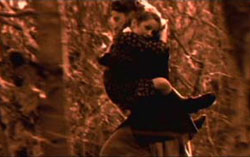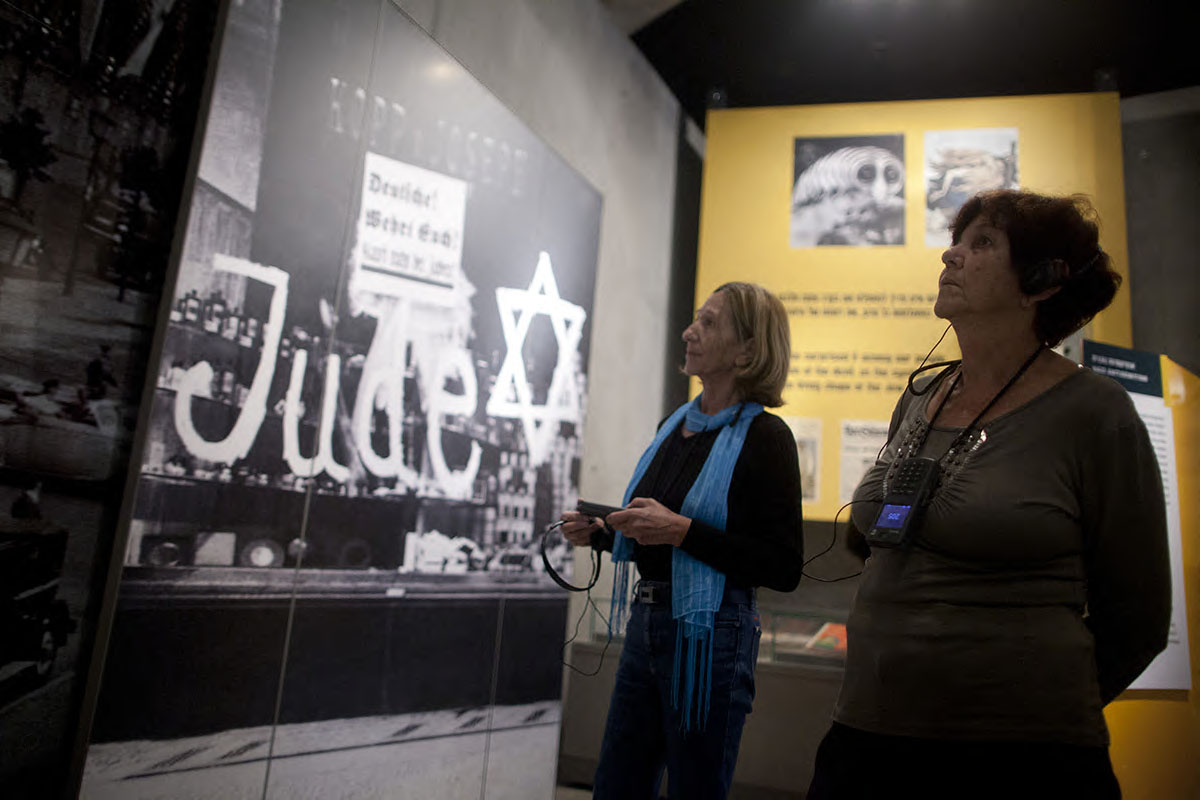
Scene from Sarah (1999)
Sunday to Thursday: 09:00-17:00
Fridays and Holiday eves: 09:00-14:00
Yad Vashem is closed on Saturdays and all Jewish Holidays.
Entrance to the Holocaust History Museum is not permitted for children under the age of 10. Babies in strollers or carriers will not be permitted to enter.

Scene from Sarah (1999)
When words are inadequate, the human body and the language of dance may be employed to tell stories and to transmit emotional content. American avant-garde filmmaker and film theorist Maya Deren referred to dance on film as “choreography for the camera.” The Toronto-basedKaeja d’Dance company uses both the stage and video dance to investigate the representation of the Holocaust and the how it is remembered. Two of their video dance productions, Zummel (7 minutes, 1999) and Sarah (6 minutes, 1999), were screened in May 2006 at Vdance, Israel’s first video dance festival, held at the Tel Aviv Cinematheque, and at a seminar at Yad Vashem’s Visual Center.
Kaeja d’Dance director and choreographer Allen Kaeja and his partner, dancer–choreographer Karen Kaeja, collaborated with film director Mark Adam on seven video dance productions based on the life story of Allen Kaeja’s father, a Holocaust survivor from Kutno, Poland. “The dances captured on film can preserve the integrity of both art forms — dance and film — and imbue them with historical significance,” explains Karen Kaeja. Allen Kaeja adds: “There is an enormous responsibility and challenge in expressing Holocaust remembrance: to represent images of loss, betrayal, uncertainty, desperation, determination and necessity without becoming melodramatic or falling into recognized patterns of expression or clichés.”
The screening at the Tel Aviv Cinematheque generated a discussion about the use of images from the Holocaust embedded in collective memory, but re-processed through the languages of dance and film. Dr. Gideon Ofrat pointed out the relationship between Kaeja d’Dance’s films and Yad Vashem’s purpose: “Yad Vashem’s mission is to document, to remember, to educate… but also to mourn through symbols. A monument is a metaphor. But the greatness of a metaphor lies in its openness to the viewer’s interpretation.Zummel can be seen as a reflection of the human condition. Zummel’s context is the Holocaust, but at the same time, by use of metaphor, it is art that transcends its context, thereby moving into the existential domain.”
Yad Vashem Directorate Chairman Avner Shalev reviewed the change that took place at the end of the twentieth century in Holocaust representation, historical research and visual documentation: “Documentation of the atrocities at Bergen-Belsen began immediately after the camp’s liberation. The American miniseriesHolocaust and Spielberg’s Schindler’s List also exemplify the great influence the visual medium has had on efforts to document the Holocaust and to perpetuate its memory. Today we stand at a crossroads, where nothing is certain, and we cannot know how the Holocaust will be remembered in another fifty years. Will it continue to live within us, as the 'raw material' of our personal and collective identities? Monumental historical narratives and visual clichés cannot shape consciousness by themselves. In the postmodern era, it is art that has the power to connect people to meaningful personal experiences that enable us to cope with the Holocaust and its memory.”
The author is Director of Yad Vashem’s Visual Center. The program was prepared with the assistance of Vdance Festival Director Avi Feldman, and the Visual Center’s Coordinator of Acquisitions & Special Projects, Mimi Ash.
English: Mimi Ash

Thank you for registering to receive information from Yad Vashem.
You will receive periodic updates regarding recent events, publications and new initiatives.

"The work of Yad Vashem is critical and necessary to remind the world of the consequences of hate"
Paul Daly
#GivingTuesday
Donate to Educate Against Hate


Worldwide antisemitism is on the rise.
At Yad Vashem, we strive to make the world a better place by combating antisemitism through teacher training, international lectures and workshops and online courses.
We need you to partner with us in this vital mission to #EducateAgainstHate
The good news:
The Yad Vashem website had recently undergone a major upgrade!
The less good news:
The page you are looking for has apparently been moved.
We are therefore redirecting you to what we hope will be a useful landing page.
For any questions/clarifications/problems, please contact: webmaster@yadvashem.org.il
Press the X button to continue



